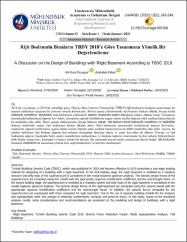Rijit Bodrumlu Binaların TBDY 2018’e Göre Tasarımına Yönelik Bir Değerlendirme
Citation
ÖZUYGUR, Ali Ruzi & Abdullah DİLSİZ. "Rijit Bodrumlu Binaların TBDY 2018’e Göre Tasarımına Yönelik Bir Değerlendirme". Uluslararası Mühendislik Araştırma ve Geliştirme Dergisi, 13.1 (2021): 243-249.Abstract
2018’de yayınlanan ve 2019’da yürürlüğe giren Türkiye Bina Deprem Yönetmeliği (TBDY) rijit bodrumlu binaların tasarımında iki aşamalı yüklemeye dayanan bir yöntemi zorunlu kılmaktadır. Birinci aşama yüklemesinde rijit bodrum kütlesiz olarak, üstyapı kendi kütlesiyle modellenir. Böylelikle mod birleştirme yöntemiyle deprem analizinde sadece üstyapının kütlesi dikkate alınır. Üstyapının tasarımında kullanılacak deprem kuvvetleri, üstyapının yapısal özelliklerine uygun olarak seçilen deprem yükü azaltma katsayılarıyla bu modelden elde edilir. İkinci aşama yüklemesinde üstyapı kütlesiz olarak, rijit bodrum kendi kütlesiyle modellenir ve böylelikle deprem analizinde sadece rijit bodrumun kütlesi dikkate alınır. Rijit bodrumun tasarımında kullanılacak deprem kuvvetleri, kendisinin yapısal özelliklerine uygun olarak seçilen deprem yükü azaltma katsayılarıyla bu ikinci modelden elde edilir. Ayrıca, bu şekilde belirlenen rijit bodrum deprem kuvvetlerine üstyapıdan aktarılan düşey ve yatay kuvvetler de eklenir. Üstyapı ve rijit bodrumun deprem hesabında farklı analiz modellerinin kullanılması ve bodrum katların tasarımında bu kuvvetlerin birleştirilmesi belli ölçüde zaman alıcı, karmaşık ve hataya müsait bir süreçtir. Bu çalışmada sayısal analiz sonuçlarına dayalı olarak, rijit bodrumlu binaların modelleme ve tasarımına yönelik bazı değerlendirmeler ve öneriler sunulmuştur. Turkish Building Seismic Code (TBSC), which was published in 2018 and became effective in 2019 prescribes a two-stage loading method for designing of a building with a rigid basement. In the first loading stage, the rigid basement is modeled as a massless structure and only mass of the superstructure is considered in the modal response spectrum analysis. The seismic design forces of the superstructure are computed using this model with the appropriate response modification coefficient and the overstrength factor. In the second loading stage, the superstructure is modeled as a massless system and only mass of the rigid basement is considered in the modal response spectrum analysis. The seismic design forces of the rigid basement are computed using this second model with the appropriate response modification coefficient and the overstrength factor. In addition, the seismic forces computed for the superstructure are superposed with those computed for rigid basement. Due to the use of separate building models for the analyses and superposition need, this process is relatively cumbersome, complex and prone to errors. In this study, based on the structural analysis results, some considerations and recommendations are presented on the modeling and design of buildings with a rigid basement.



















